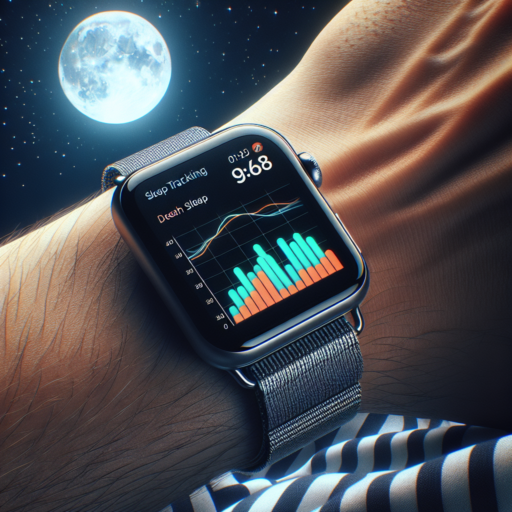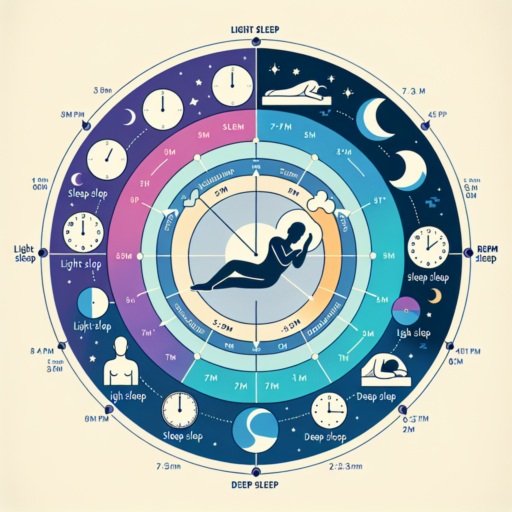Understanding How Smartwatches Track Sleep
Smartwatches have revolutionized the way we monitor our health, including our sleep patterns. The technology behind this feature is both fascinating and complex. It primarily involves the use of accelerometers and heart rate sensors to provide a comprehensive overview of your sleep cycle. This article delves into the mechanisms that enable smartwatches to track sleep, shedding light on the accuracy and utility of the data collected.
At the core of sleep tracking technology are accelerometers, which detect motion. When you wear a smartwatch to bed, it continuously measures your movements throughout the night. Small movements can indicate that you’re in a lighter phase of sleep, such as REM, while a lack of movement signals a deeper sleep phase, like deep sleep. By analyzing these patterns, smartwatches can construct a sleep cycle chart that helps users understand their sleep quality.
Another crucial component is the heart rate sensor. Most smartwatches are equipped with sensors that monitor your heartbeat continuously. During sleep, your heart rate varies depending on the sleep stage you’re in. For instance, during deep sleep, your heart rate decreases, and during REM sleep, it may increase or become more variable. Smartwatches use these heart rate patterns, along with movement data, to further refine their sleep stage analysis. This combined data approach enables a more accurate depiction of your sleep quality, offering insights into how well you’re resting and potential areas for improvement.
No se han encontrado productos.
The Technology Behind Sleep Tracking in Smartwatches
The fascination with sleep quality and its impact on our daily lives has driven the integration of sleep tracking technology into smartwatches. This feature represents a blend of advanced sensors and sophisticated algorithms designed to monitor sleep patterns and stages. At its core, sleep tracking in smartwatches hinges on the ability to accurately detect and interpret a user’s movements and physiological signals during sleep.
Key Components of Sleep Tracking
Actigraphy: At the heart of most smartwatch sleep tracking functions lies actigraphy. Using an accelerometer, the device measures movements, which can then be analyzed to distinguish between sleep and wakefulness. Because different sleep stages exhibit varying levels of activity, these data, when processed, provide insights into the user’s sleep cycle.
Heart Rate Monitoring: Another crucial element is continuous heart rate monitoring. Smartwatches employ optical heart rate sensors to detect blood flow variations, which correlate with different sleep stages. Fast and slow heart rate patterns are indicative of REM (Rapid Eye Movement) sleep and deep sleep stages, respectively, offering a more nuanced view of sleep quality.
Software Algorithms and Sleep Analysis
The real magic, however, lies in the software algorithms that take raw data from sensors and translate it into understandable sleep metrics. These algorithms use machine learning to improve accuracy over time, differentiating between various sleep states more effectively. Thus, users receive detailed sleep analysis, including duration, efficiency, and disturbances, enabling a deeper understanding of their sleep health.
Comparing Different Smartwatches: Accuracy in Sleep Tracking
When exploring the world of smartwatches, one feature that often catches the eye is sleep tracking. Various brands claim their devices use cutting-edge technology to monitor sleep patterns, but how accurate are they really? Understanding this can help you make an informed decision on which smartwatch might best fit your lifestyle and sleep monitoring needs.
Key Factors Influencing Sleep Tracking Accuracy
- Wearable Sensor Technology: The precision of sleep tracking can vary significantly depending on the type of sensors used by the smartwatch. Optical heart rate monitors, accelerometers, and gyroscopes play crucial roles in detecting sleep stages.
- Algorithm Efficiency: The software algorithms that interpret the data collected by the watch’s sensors are vital for accuracy. These algorithms differentiate between light, deep, and REM sleep phases based on your movements and heart rate patterns throughout the night.
- User Behavior and Wearability: How and where you wear your smartwatch can also affect sleep tracking accuracy. Devices worn too loosely might not capture data accurately, whereas tightly worn watches can cause discomfort, potentially disrupting sleep.
Each brand has its approach to optimizing these factors for the most accurate sleep tracking possible. Brands like Fitbit, Garmin, and Apple have developed reputations for their reliable and accurate health monitoring features, including sleep tracking. However, it’s essential to dive deeper into user reviews and independent research studies to understand how each model from these brands performs under real-world conditions.
Maximizing Your Sleep Analysis: Tips and Tricks Using Your Smartwatch
Sleep is a crucial component of our health, and with the advent of smartwatch technology, monitoring and improving sleep patterns has never been easier. By utilizing the sophisticated sensors and the latest software in your smartwatch, you can gain detailed insights into your sleep quality. Here are several tips and tricks to maximize your sleep analysis using your smartwatches.
Understand Your Sleep Data
Firstly, take the time to understand the data your smartwatch provides. Modern devices offer a breakdown of sleep stages—light, deep, and REM sleep. Recognizing the patterns and durations of these stages can help you identify areas of improvement. A consistent analysis over time can reveal the effectiveness of various strategies you adopt to enhance sleep quality.
Optimize Your Sleep Environment
Your bedroom environment plays a significant role in the quality of your sleep. Use your smartwatch data to experiment with changes and measure their effect. Consider factors such as room temperature, noise, and light levels. For instance, you may find that cooler room temperatures lead to more deep sleep, as indicated by your smartwatch data. Adjusting your environment based on feedback from your device can lead to significant improvements in sleep quality.
Leverage Sleep Tools and Features
Do not overlook the built-in tools and features of your smartwatch designed to enhance sleep. Many devices offer functionalities like sleep schedules, reminders to wind down, and even relaxation exercises. Utilizing these tools can help you establish a consistent bedtime routine, which is vital for optimizing sleep quality. Also, some smartwatches provide suggestions based on your sleep trends, offering personalized advice to further improve your sleep experience.
The Health Benefits of Monitoring Your Sleep with a Smartwatch
Monitoring your sleep with a smartwatch has become an increasingly popular way to gain insights into your sleep patterns and overall health. Keeping a close eye on the quality and quantity of your sleep can lead to significant health benefits. The integration of advanced sensors and health monitoring technologies in smartwatches allows for detailed sleep tracking, which in turn can help in identifying sleep disorders early on and improving one’s lifestyle and sleep habits.
Enhanced Sleep Quality: By analyzing your sleep patterns, smartwatches can provide recommendations for improving the quality of your sleep. This could include changes in your bedtime routine or identifying potential disturbances that might be affecting your sleep cycle. Moreover, understanding the different sleep stages you go through each night can be crucial for ensuring that you get enough restorative sleep, which is essential for your body’s recovery and overall well-being.
Physical Health Benefits: A good night’s sleep is linked to a wide range of physical health benefits. Improved sleep quality and duration can boost your immune system, reduce the risk of heart disease, and assist in weight management. By monitoring your sleep with a smartwatch, you can make informed decisions about your health and lifestyle changes to enhance your sleep and, consequently, your physical health.
Decoding Sleep Patterns: What Your Smartwatch Can Reveal
With the advent of wearable technology, understanding the nuances of our sleep patterns has become more accessible than ever before. Your smartwatch, a device once relegated to tracking steps and receiving notifications, has now become a window into the mysterious world of sleep. It offers a treasure trove of data about your sleep habits, potentially revealing insights into your overall health and well-being.
Smartwatches leverage various sensors to monitor your movements and heart rate throughout the night. This data is then used to analyze the quality and quantity of your sleep, distinguishing between light, deep, and REM (Rapid Eye Movement) sleep stages. Understanding the significance of these stages is crucial, as each plays a vital role in the restorative process of sleep. For instance, deep sleep is essential for physical recovery, whereas REM sleep is associated with memory consolidation and emotional processing.
Interpreting Your Smartwatch’s Sleep Data
Upon waking up, your smartwatch presents you with a detailed breakdown of your sleep cycle, including the duration spent in each stage of sleep and periods of wakefulness. This data, often presented in easy-to-understand graphs and charts, offers a clear glimpse into your sleep efficiency. Regular monitoring can unveil patterns, such as the impact of lifestyle choices on your sleep quality. For example, you might notice that physical activity during the day leads to an increased amount of deep sleep, or that consuming caffeine late in the day can disrupt your sleep continuity.
However, while smartwatches provide invaluable insights, they should not replace professional medical advice. If your device indicates frequent sleep disturbances or consistently poor sleep quality, it may be a signal to seek guidance from a healthcare provider. Ultimately, your smartwatch acts as a guide, helping you to fine-tune habits and routines for a better night’s sleep, but it’s crucial to consult with professionals when necessary.
How Smartwatches Use Motion and Heart Rate to Analyze Sleep Quality
Smartwatches have revolutionized the way we monitor our health, integrating technology to provide insights into our daily lives. Understanding how these devices use motion and heart rate to analyze sleep quality illuminates the sophistication behind wearable technology. By observing subtle changes in movement and pulse, smartwatches offer a window into our sleep patterns, providing data that can be crucial for improving our health and well-being.
At the heart of this technology lies the integration of accelerometers and heart rate monitors. Accelerometers, which detect body movements, play a crucial role in identifying sleep stages. During sleep, the body cycles through different stages, each characterized by varying levels of activity. For instance, the rapid eye movement (REM) stage, indicative of deep sleep, has minimal physical movement compared to other stages. By analyzing these variations in motion, smartwatches can estimate the duration and quality of sleep.
Similarly, heart rate monitoring adds another layer of analysis. The physiological changes that occur during sleep affect heart rate dynamics. Throughout a sleep cycle, heart rate typically slows during non-REM sleep and fluctuates during REM sleep. By continuously measuring these changes, smartwatches can provide insights into heart health and stress levels, further augmenting the sleep quality assessment.
Improving Sleep Quality: How Feedback from Smartwatches Can Help
In the modern era, where technology intertwines with daily life, the quest for better sleep has seen a revolutionary participant: smartwatches. These devices, primarily designed for fitness tracking and notifications, have begun to offer insights into our sleep patterns, transforming them into powerful tools for enhancing sleep quality. By monitoring movements and heart rate throughout the night, smartwatches provide valuable feedback that can be pivotal in identifying and tackling sleep disturbances.
One of the core benefits of utilizing smartwatch feedback is its ability to identify sleeping trends. Over time, these devices compile data that reveal patterns and correlations between daily activities and sleep quality. This could mean recognizing the impact of late-night exercise or caffeine consumption on your ability to fall and stay asleep. Armed with this data, individuals can make informed decisions about their pre-sleep routines, setting the stage for a night of deeper, more restorative sleep.
Furthermore, smartwatches often come equipped with features specifically designed to improve sleep. From gentle vibrations for waking up at the optimal sleep stage to ambient sounds that aid in falling asleep, the feedback provided is not just data-driven but also actionable. Users report significant improvements in not only the duration but also the quality of their sleep, thanks to customized insights and suggestions based on their sleep cycles.
From Light to REM: Understanding Sleep Stages with Your Smartwatch
Exploring the journey from light sleep to deep REM (Rapid Eye Movement) stages is fascinating, especially when we have technology like smartwatches to guide us. The details and insights provided by these gadgets offer us a unique window into our sleep patterns, enabling us to optimize our rest for better health and wellbeing.
Decoding Sleep Stages
Understanding the different stages of sleep is crucial for interpreting the data your smartwatch provides. Initially, we start with the light sleep stage, which is the transition from wakefulness to sleep. It’s easy to wake up from this stage, making it less restorative. As we progress, the body enters a deeper sleep phase, known as deep sleep, which is rejuvenating and vital for physical repair. Finally, the REM stage, characterized by rapid eye movements, is where dreaming occurs and plays a key role in memory consolidation and mood regulation.
How Your Smartwatch Tracks Sleep
Smartwatches use a combination of sensors and algorithms to monitor your sleep stages. By measuring heart rate variability (HRV), movements, and sometimes even oxygen saturation, these devices can approximate when you’ve transitioned from light sleep to deep sleep and into REM. While not as accurate as professional sleep studies, the information captured can be incredibly beneficial for personal health tracking and behavioral adjustments.
Owing to advancements in technology, our smartwatches now provide us with detailed insights into our sleep architecture. By understanding the nuances between light, deep, and REM sleep stages, we can appreciate the complexity of our sleep patterns and the importance of each stage. This knowledge, combined with the data from our smartwatches, empowers us to make informed decisions about sleep habits, environment modifications, and potentially, lifestyle changes to enhance our overall sleep quality.
Privacy and Safety: What You Need to Know About Sleep Data from Smartwatches
The burgeoning world of smartwatches has revolutionized the way we monitor and understand our health, especially our sleep patterns. As these devices delve deeper into our personal lives, they gather copious amounts of data. Understanding the privacy and safety implications of this data collection is crucial for every user. Smartwatches, while helpful in tracking sleep quality, duration, and patterns, also raise essential questions about what happens to our data once it’s been collected.
First and foremost, it’s important to recognize that the data collected by your smartwatch is more than just numbers and charts. It’s a comprehensive overview of your health and habits. Companies use this data to improve their products, but it can also be a potential target for hackers. The safety of your sleep data hinges on the security protocols implemented by the smartwatch manufacturers. Encryption and user authentication methods are pivotal in safeguarding your information from unauthorized access.
Another aspect to consider is the privacy policies of the companies behind these smartwatches. It’s imperative to understand how your data is being used. Is it being shared with third parties? For what purposes? Transparency in these policies can often be the deciding factor for users concerned about their data’s privacy and safety. Moreover, many users are unaware that they might be granting permissions that allow for more invasive data collection than they intended. Scrutinizing the permissions you give is not just recommended; it’s a necessity for maintaining control over your personal information.




